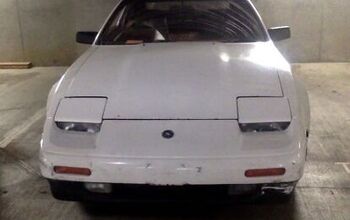Crapwagon Outtake: 1992 Mazda MX-3 GS

Today brings Round Two in the “Obscure Project Car That Probably Should Be a Parts Car” series this week. Commenter dwford mentioned the Mazda MX-3 in reply to Monday’s Isuzu, and it reminded me that I haven’t seen one for quite a while as they were prone to rust and rice-ification.
Leave it to Mazda to bring another oddball engine to market in a low-volume sports car. What other company would build and sell a 130 horsepower, 1.8-liter V-6, especially when a four-cylinder engine with similar power was readily available? I thank the iconoclast engineers in Hiroshima for greenlighting the unique “K8-DE” powerplant.
Today’s 1992 Mazda MX-3 GS is certainly a project that likely won’t return much in the way of value in the end. Its 200,000 miles of use is a big turnoff, though we’ll get to that in a bit. The interior needs to be gone through completely, and the door seals and sunroof need replacement for this to be a viable driver. Some time and money will need to be spent on the bodywork, as well. At least it seems replacement bumper covers have been fitted, though without painting. As is, this could be a good starting point for a LeMons racer.
However, I’d likely dump the baby V-6 in favor of a 2.5-liter version. The common MX-6/Ford Probe engine easily achieves 170 horsepower, but a 200 horsepower “KL-ZE” only sold in Japan is an attractive option that brings some wonderful sonic qualities.
I vaguely recall the magazines of the day comparing the MX-3 to the departed Honda CRX, and I can see it — to a point. The Mazda was heavier, though had a little bit more power. The strut suspension, however, was never quite as nice in the twisties as the Honda double A-arm. The extra power of the engine swap would fix that nicely.
I’m an automotive masochist, but even I wouldn’t buy this Mazda. The work involved would never pay off if I got bored with it. I’m sure there are KL-swapped cars out there for a song.

Some enthusiasts say they were born with gasoline in their veins. Chris Tonn, on the other hand, had rust flakes in his eyes nearly since birth. Living in salty Ohio and being hopelessly addicted to vintage British and Japanese steel will do that to you. His work has appeared in eBay Motors, Hagerty, The Truth About Cars, Reader's Digest, AutoGuide, Family Handyman, and Jalopnik. He is a member of the Midwest Automotive Media Association, and he's currently looking for the safety glasses he just set down somewhere.
More by Chris Tonn
Latest Car Reviews
Read moreLatest Product Reviews
Read moreRecent Comments
- GrumpyOldMan All modern road vehicles have tachometers in RPM X 1000. I've often wondered if that is a nanny-state regulation to prevent drivers from confusing it with the speedometer. If so, the Ford retro gauges would appear to be illegal.
- Theflyersfan Matthew...read my mind. Those old Probe digital gauges were the best 80s digital gauges out there! (Maybe the first C4 Corvettes would match it...and then the strange Subaru XT ones - OK, the 80s had some interesting digital clusters!) I understand the "why simulate real gauges instead of installing real ones?" argument and it makes sense. On the other hand, with the total onslaught of driver's aid and information now, these screens make sense as all of that info isn't crammed into a small digital cluster between the speedo and tach. If only automakers found a way to get over the fallen over Monolith stuck on the dash design motif. Ultra low effort there guys. And I would have loved to have seen a retro-Mustang, especially Fox body, have an engine that could rev out to 8,000 rpms! You'd likely be picking out metal fragments from pretty much everywhere all weekend long.
- Analoggrotto What the hell kind of news is this?
- MaintenanceCosts Also reminiscent of the S197 cluster.I'd rather have some original new designs than retro ones, though.
- Fahrvergnugen That is SO lame. Now if they were willing to split the upmarketing price, different story.


































Comments
Join the conversation
Mazda chose to slap a "Precidia" badge on the MX-3 here in Canada, which pretty much ensured that only the most self-confident male would ever be caught dead in one. The little V6 was kinda pointless from a performance perspective - I mean the Nissan NX2000 ate it for breakfast - but it gave off a smooth snarl that was quite pleasing to the ear.
I own one of these. The main problem with most of them, is that they've been beat on by adolescent boys. If you're lucky enough to find a clean one, they're sweet little cars. For the most part, they're pretty reliable. The biggest issue with them is the distributor, a complicated piece containing ignitor, cam and crank sensors. They frequently crap out, and are difficult to diagnose for those not familiar with them. They're also worth $600 at the dealership – probably another reason you'd find them dumped "as is" in the want ads. For about $20 in parts, there's an "HEI" bypass to the ignition in the disty that solves the stalling/dying issue. The stock 1.6 was created as a smoother, more balanced alternative to the typical 4-bangers of the day. Sweet running engine, but unfortunately, underpowered. The 2.5L KLZE is a direct bolt-in, and the end result is a car that feels exactly as it should. I had it out to a couple of lapping days at Mosport and though it's a slow car, it's a great handler. Mine's currently undergoing a complete restoration - I'm up to my armpits in bead-blasting right now. The KLZE went in with no issues, I sourced an original, near-mint leather interior and the suspension will be going in next week.